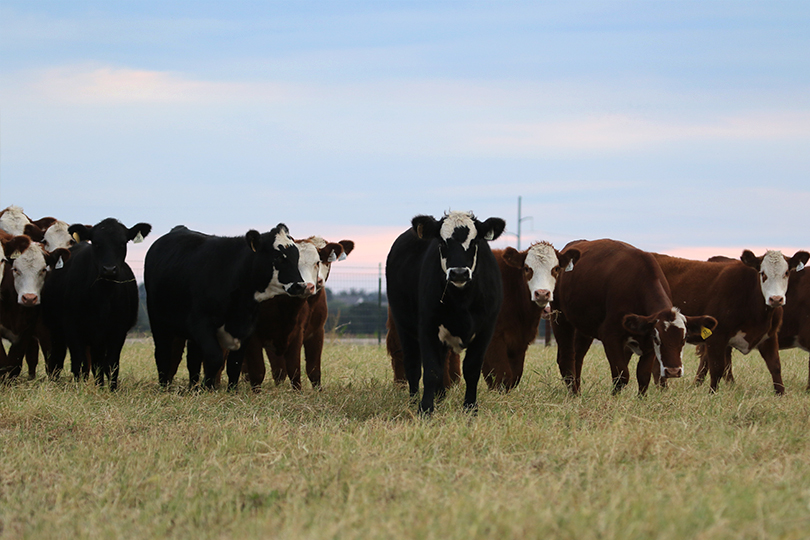By Jennifer Dorsett
Field Editor
Replacement heifer development is a major investment for any cow-calf operation, impacting the rancher’s bottom line for years to come.
“It’s critical to your profitability to select the right heifers,” Dr. Jared Ranly, owner of Ranly Veterinary Services, said. “Replacement heifer selection is a multifaceted endeavor that should continue throughout the development period.”
Ranly’s client base consists of mainly beef cattle operators in and around Falls County.
“There is some corn grown in Falls County and a few other crops, but this area is historically known for raising stocker calves,” Ranly, a Falls County Farm Bureau member, said. “I always wanted to have a beef cattle veterinary practice. I did a little bit of everything when I first graduated and moved back here, but I was able to go to exclusively beef cattle in a short amount of time. That’s my primary focus now.”
According to Ranly, there are three main periods ranchers should consider when selecting replacement heifers: at weaning, pre-breeding and pregnancy diagnosis.
Weaning
Weaning is the most common time for ranchers to consider potential replacement heifers. Selecting potential replacements that were born within the first half of calving season gives the rancher the greatest chance of having heifers that have reached puberty by the beginning of breeding season.
“Get them old enough so that they’re cycling at the beginning of the season,” he said. “That’s probably the biggest thing to keep in mind. If they’re not breeding that year, they’re not making you money.”
Ranly noted ranchers should cull any heifers from problem cows with poor disposition, conformation or teat and udder problems, and from any cows that fail to produce an acceptable calf each year.
Frame size is important, too. Heifers that are moderately sized are generally the most profitable cows, Ranly said. Keeping only the biggest heifers will increase the herd’s frame size and mature cow weight over time.
“General conformation is essential in selecting replacements,” he said. “Evaluate their feet and leg structure critically, as they worsen with maturity. Select heifers that look feminine and eliminate any that are excessively masculine or look like steers.”
Udder structure may be hard to determine in weaning heifers but eliminating those with obvious problems and those from cows with poor udder structure will help prevent higher instances of future udder or teat issues in the herd.
Pre-breeding
Many ranchers have their veterinarian perform breeding soundness exams on bulls before the breeding season, but Ranly said few take advantage of pre-breeding exams on replacement heifers.
During a pre-breeding heifer exam, a veterinarian will conduct pelvic size measurements and palpate the reproductive tract to evaluate the size of the uterus and presence of ovarian structures. Then a reproductive tract score is assigned to the animal.
“This allows us to identify heifers that have reached puberty and are good candidates to conceive early in the breeding season,” Ranly, who also chairs Texas Farm Bureau’s Animal Health Advisory Committee, said. “It also eliminates any heifers that have reproductive tract abnormalities and so will never breed, as well as heifers that are already bred.”
Pelvic size measurements will help cull any heifers from the herd that have abnormally small pelvises and are at a greater risk for cesarean sections, what Ranly called “hard pulls” or difficult births, and death loss.
“Pre-breeding exams have a cost, but they’re easily offset by savings from eliminating development, breeding and health costs of heifers that aren’t likely to breed or produce live calves,” he said.
Pregnancy diagnosis
Determining the length of a breeding season for replacement heifers should depend on the number of replacement animals needed and marketing opportunities for bred heifers, Ranly noted.
Choosing bred heifers as replacements that have conceived within the first 60 days or less of the breeding season is a good guideline to follow.
“Heifers adequately developed on a good nutritional program that have reached puberty should breed early within the breeding season,” he said. “Heifers that breed late in the breeding season are more likely to breed late in subsequent breeding seasons or fail to breed back at all.”
If there is a market for bred heifers, ranchers can use a longer breeding season to maximize pregnant heifers. This lets ranchers choose the heifers that bred early within the season as replacement animals and market the later-breeding heifers.
If marketing bred replacements isn’t profitable in that area or at that time, a shorter breeding season of 60 days or less allows ranchers to diagnose pregnancies early and market open heifers earlier as feeder calves instead of selling them later at cull cow prices, he added.
“The heifers you select for replacements today will affect the genetic makeup of your herd for years to come,” Ranly said. “A heifer calf selected at weaning will usually require two years of investment before she produces a market-ready calf. So, it’s a major decision to make, and it pays to choose those animals carefully.”

